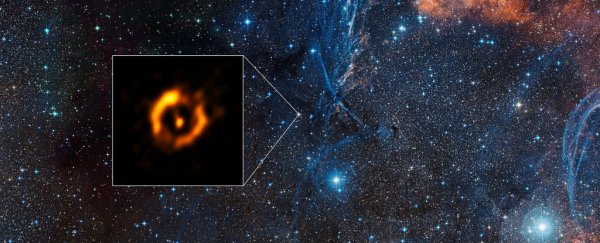Earth was born from a ring of dust some 4.5 billion years ago. In fact, that's how every planet is formed - a disc of dust swirled around a star and eventually clumped together enough to form large masses. But until now, astronomers were only able to capture images of these dust clouds hanging around young stars.
Those days are over, though, because a team working with the Very Large Telescope Interferometer at the European Southern Observatory's (ESO) Paranal Observation in Chile have just captured the first crisp image of an ageing star's dust ring, which means that old, dying stars could be creating a second generation of planets.
Researchers have known for decades that ageing stars develop dust rings over time - the result of materials getting swept up in stellar winds. But without a proper image to study, no one's had the chance to properly compare these dust clouds to those of younger stars. Now, thanks to this new image, they finally can.
According to the ESO, astronomers from Belgium's Instituut voor Sterrenkunde targeted a double star named IRAS 08544-4431 (a name that just rolls off the tongue), which lies roughly 4,000 light-years from Earth. The star system features an old red dwarf that has been accumulating a ring of dust for some time now, and a normal, smaller star that orbits it.
Though it may seem easy to snap a picture of the night sky, the amount of imaging technology and level of scientific understanding needed to capture such a crisp image is mind-boggling. As Jacques Kluska from the University of Exeter explains:
"By combining light from several telescopes of the Very Large Telescope Interferometer, we obtained an image of stunning sharpness - equivalent to what a telescope with a diameter of 150 metres would see. The resolution is so high that, for comparison, we could determine the size and shape of a one-euro coin seen from a distance of two thousand kilometres."
Since the new image captures the dust ring so well, teams of researchers will now try to figure out just how close it resembles that of a young star.
The most interesting question is whether or not rings around old stars can form a second generation of planets, which is made all the more interesting given the fact that IRAS 08544-4431 is already unique because it consists of two stars instead of one.
As more research is conducted, we will hopefully have a better understanding of the physics at work in these discs, how double stars form, and many other long-sought-after stellar inquiries. Until then, we have a remarkable new image to get lost in.
